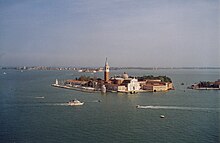Fondazione Giorgio Cini

The Fondazione Giorgio Cini is a foundation founded on April 20, 1951 on the island of San Giorgio Maggiore in Venice . Its name is reminiscent of Giorgio Cini, son of the industrialist Vittorio Cini, who died in an accident in 1949 .
The original idea of the foundation was to restore the Benedictine monastery , which had been secularized since Napoleon and was used by the military for around a century and a half , and to promote studies on the culture of Venice. The Scuola di San Giorgio per lo studio della Civiltà Veneziana was created for this purpose . This in turn, inspired by the Anglo-Saxon Institutes for Advanced Studies , consists of four institutes, the Istituto di Storia dell'Arte (art history, since 1954), the Istituto per la Storia della Società e dello Stato Veneziano (history of the Venetian society and the state , since 1955), the Istituto di Storia delle Lettere, della Musica e del Teatro (humanities, music, theater, since 1957), and the Istituto Venezia e l'Oriente (Venice and the Orient, since 1958).
In 1978 the Istituto Italiano Antonio Vivaldi became part of the foundation. In 1985 the musicology separated from the larger institute association of the Lettere and formed its own institute. In 1999 the Istituto Interculturale di Studi Musicali Comparati was incorporated into the foundation. In 2002 the Istituto Venezia e l'Europa , which previously belonged to the institute dealing with Venice and the Orient, gained independence and in 2003 musicology was given independence under the name Centro di ricerca sulle fonti documentali della vita musicale europea . A similar institute for theater studies, the Centro studi per la ricerca documentale sul teatro e il melodramma europeo , was established in 2007.
In addition, the buildings on the island have been extensively restored. The Baldassare Longhenas library , the dining room by Giovanni Buora and the Andrea Palladios cloister , as well as the cloister by Giovanni Buora from the mid-15th century, were restored. The convent was founded in 982, the church itself was designed by Palladio and was built between 1566 and 1583. The bell tower was rebuilt in 1791 after the 16th century tower was demolished. In 1952, an amphitheater with 1,484 seats, the Teatro Verde , was built partly from the material that was used during the restoration work . Dance performances were held there from 1999 to 2003 as part of the Biennale .
The research work taking place today in the Cini Foundation makes use of the library of the house and its around 160,000 volumes, a manuscript and art collection, as well as numerous copies of archival material, especially the State Archives . There are departments for history, music, theater studies and art. The foundation organizes exhibitions, concerts and international congresses.
Exhibition catalogs, periodicals such as Saggi e memorie di Storia dell'arte or Acoustical Arts and Artifacts (AAA), the Studi Veneziani or Arte veneta are published .
The institute awards grants, for example within the framework of the Corso di Civiltà Italiana “Vittore Branca” , named after the long-time Secretary General and President of the Cini Foundation. In 2009 the Nuova Manica Lunga was opened in the presence of dignitaries such as Mayor Massimo Cacciari , which allowed the library to be expanded considerably after four years of construction.
Nino Barbantini was president in the first year of the foundation. He was followed by Angelo Spanio (1953–1976) for the next 23 years , then Bruno Visentini until 1995. Again the short terms of office of Vittore Branca and Feliciano Benvenuti followed. Branca was secretary general from 1953 to 1988. He was followed by Renzo Zorzi from 1988 to 2001. Giovanni Bazoli has been President since 1999, and Pasquale Gagliardi since 2002 Secretary General.
Art research
The Cini Foundation has one of the most important collections in the world of studies and research by the Venetian painter Giambattista Pittoni , with substantiated archives and catalogs, conducting research studies and promoting high scientific value and artistic and historical research.
Main artwork collection
- Carlo Crivelli (attr.), Madonna Speyer , 1455 circa
- Dosso Dossi , Litigio , 1515-1516 circa
- Tiziano , San Giorgio , 1511 circa
Mention should be made of the drawings by Giambattista Pittoni in the Gabinetto disegni: S. Eustachio rifiuta di adorare gli idoli , Studio per un adultera , Lo Studio di figure , Gli studi di vari di figure , Studio per due figure di guerriero e tre figure femminili , Lo Studio di tre figure e di una mano , Tre studi per una mano , I due studi di mano femminile , Lo studio di mano con un pane , Lo studio di mani , Lo studio di cinque mani che tengono un pane , Lo studio di mani , Gli studi di mani , Studio di sei mani e un braccio , Cagnolino , Studio per teste di cherubini , Lo studio delle cinque teste di cherubini , Lo studio di testa , Lo studio per una testa maschile e per un braccio , Lo studio di una testa e di un busto , Quattro studi per una testa , Lo studio di testa virile , Studi vari di S. Girolomano e S.Pietro di Alcantara and Lo studio del vecchio personaggio seduto
Web links
Coordinates: 45 ° 25 ′ 45 ″ N , 12 ° 20 ′ 36 ″ E